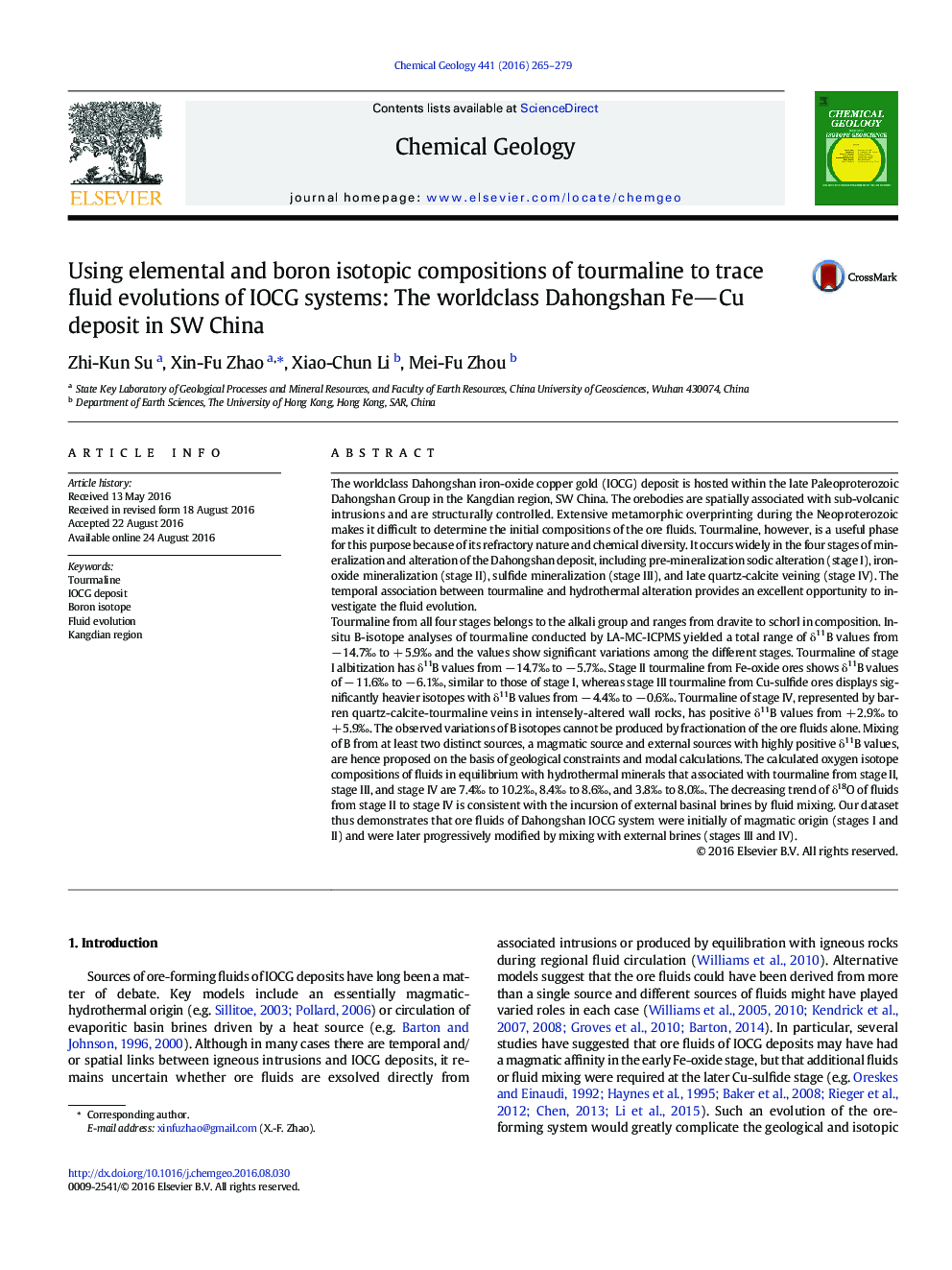| کد مقاله | کد نشریه | سال انتشار | مقاله انگلیسی | نسخه تمام متن |
|---|---|---|---|---|
| 4698223 | 1637533 | 2016 | 15 صفحه PDF | دانلود رایگان |

• Boron isotopes of tourmaline from different stages have a record of fluid evolution.
• Albitization of the Dahongshan deposits are formed by dominantly magmatic fluids.
• Ore fluids are mainly of magmatic B in Fe-oxide stage and evolve into mixed B signatures in Cu-sulfide stage.
• Mixing of magmatic and external fluids is important for economic Cu mineralization in IOCG deposits.
The worldclass Dahongshan iron-oxide copper gold (IOCG) deposit is hosted within the late Paleoproterozoic Dahongshan Group in the Kangdian region, SW China. The orebodies are spatially associated with sub-volcanic intrusions and are structurally controlled. Extensive metamorphic overprinting during the Neoproterozoic makes it difficult to determine the initial compositions of the ore fluids. Tourmaline, however, is a useful phase for this purpose because of its refractory nature and chemical diversity. It occurs widely in the four stages of mineralization and alteration of the Dahongshan deposit, including pre-mineralization sodic alteration (stage I), iron-oxide mineralization (stage II), sulfide mineralization (stage III), and late quartz-calcite veining (stage IV). The temporal association between tourmaline and hydrothermal alteration provides an excellent opportunity to investigate the fluid evolution.Tourmaline from all four stages belongs to the alkali group and ranges from dravite to schorl in composition. In-situ B-isotope analyses of tourmaline conducted by LA-MC-ICPMS yielded a total range of δ11B values from − 14.7‰ to + 5.9‰ and the values show significant variations among the different stages. Tourmaline of stage I albitization has δ11B values from − 14.7‰ to − 5.7‰. Stage II tourmaline from Fe-oxide ores shows δ11B values of − 11.6‰ to − 6.1‰, similar to those of stage I, whereas stage III tourmaline from Cu-sulfide ores displays significantly heavier isotopes with δ11B values from − 4.4‰ to − 0.6‰. Tourmaline of stage IV, represented by barren quartz-calcite-tourmaline veins in intensely-altered wall rocks, has positive δ11B values from + 2.9‰ to + 5.9‰. The observed variations of B isotopes cannot be produced by fractionation of the ore fluids alone. Mixing of B from at least two distinct sources, a magmatic source and external sources with highly positive δ11B values, are hence proposed on the basis of geological constraints and modal calculations. The calculated oxygen isotope compositions of fluids in equilibrium with hydrothermal minerals that associated with tourmaline from stage II, stage III, and stage IV are 7.4‰ to 10.2‰, 8.4‰ to 8.6‰, and 3.8‰ to 8.0‰. The decreasing trend of δ18O of fluids from stage II to stage IV is consistent with the incursion of external basinal brines by fluid mixing. Our dataset thus demonstrates that ore fluids of Dahongshan IOCG system were initially of magmatic origin (stages I and II) and were later progressively modified by mixing with external brines (stages III and IV).
Journal: Chemical Geology - Volume 441, 21 November 2016, Pages 265–279